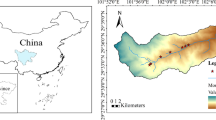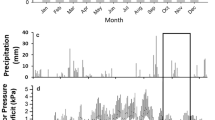Abstract
We studied changes in stand structure, productivity, canopy development, growth efficiency, and intrinsic water use efficiency (WUE=photosynthesis/stomatal conductance) of the native tree koa (Acacia koa) across a gradient of decreasing rainfall (2600–700 mm) with increasing elevation (700–2000 m) on the island of Hawaii. The stands were located on organic soils on either smooth (pahoehoe) or rough (aa) lava flows. In the greenhouse, we also examined growth and WUE responses to different water regimes of koa seedlings grown from seeds collected in the study area. We tested the hypotheses that (1) stand basal area, aboveground net primary productivity (ANPP), leaf area index (LAI), and growth per unit leaf area decreased with decreasing rainfall, (2) WUE increased with decreasing rainfall or water supply, and (3) WUE responses were caused by stomatal limitation rather than by nutrient limitations to photosynthesis. The carbon isotope composition of phyllode tissues (δ13C) was examined as an integrated measure of WUE. Basal area and LAI of koa stands on both pahoehoe and aa lava flows, and ANPP on aa lava flows decreased with elevation. Basal area, LAI, and ANPP of koa in mixed stands with the exotic tropical ash (Fraxinus udhei) were lower compared to single-species koa stands at similar elevations. Along the gradient, phyllode δ13C (and therefore WUE) increased with elevation from –30.2 to –26.8‰. Koa in mixed stands exhibited higher (less negative) δ13C than in single-species stands suggesting that koa and tropical ash competed for water. In the greenhouse, we observed the same trend observed in the field, as phyllode δ13C increased from –27.7 to –24‰ as water supply decreased. Instantaneous gas exchange measurements in the greenhouse showed an inverse correlation of both maximum (morning) photosynthesis (A) and conductance (g) with δ13C values and, also, a good agreement between instantaneous (A/g) and integrated measures of WUE. Phyllode δ13C was not correlated with foliar concentrations of N or other nutrients in either the field or the greenhouse, indicating that differences in δ13C were caused by stomatal limitation rather than by nutrient-related changes in photosynthetic capacity. This study provided evidence that long-term structural and growth adjustments as well as changes in WUE are important mechanisms of koa response to water limitation.
Similar content being viewed by others
Author information
Authors and Affiliations
Additional information
Received: 17 December 1998 / Accepted: 4 August 1999
Rights and permissions
About this article
Cite this article
Ares, A., Fownes, J. Water supply regulates structure, productivity, and water use efficiency of Acacia koa forest in Hawaii. Oecologia 121, 458–466 (1999). https://doi.org/10.1007/s004420050952
Issue Date:
DOI: https://doi.org/10.1007/s004420050952




